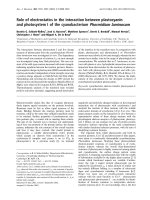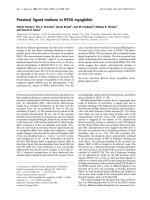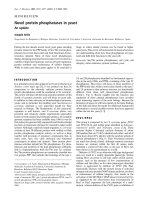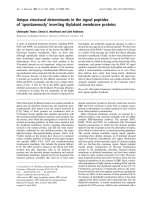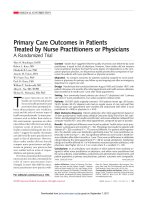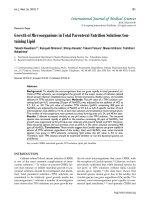Báo cáo y học: "Poorer sustained attention in bipolar I than bipolar II disorde" doc
Bạn đang xem bản rút gọn của tài liệu. Xem và tải ngay bản đầy đủ của tài liệu tại đây (222.67 KB, 7 trang )
PRIMARY RESEARCH Open Access
Poorer sustained attention in bipolar I than
bipolar II disorder
Chian-Huei Kung
1
, Sheng-Yu Lee
2,3
, Yun-Hsuan Chang
2,4
, Jo Yung-Wei Wu
4
, Shiou-Lan Chen
1,2,3
,
Shih-Heng Chen
1,2,3
, Chun-Hsien Chu
1,2,3
, I-Hui Lee
2,3
, Tzung-Lieh Yeh
2,3
, Yen-Kuang Yang
2,3
, Ru-Band Lu
1,2,3,4*
Abstract
Background: Nearly all information proce ssing during cognitive processing takes place during periods of sustained
attention. Sustained attention deficit is among the most commonly reported impairments in bipolar disorder (BP).
The majority of previous studies have only focused on bipolar I disorder (BP I), owing to underdiagnosis or
misdiagnosis of bipolar II disorder (BP II). With the refinement of the bipolar spectrum paradigm, the goal of this
study was to compare the sustained attention of interepisode patients with BP I to those with BP II.
Methods: In all, 51 interepisode BP patients (22 with BP I and 29 with BP II) and 20 healthy controls participated in
this study. The severity of psychiatric symptoms was assessed by the 17-item Hamilton Depression Rating Scale
and the Young Mania Rating Scale. All participants undertook Conners’ Continuous Performance Test II (CPT-II) to
evaluate sustained attention.
Results: After controlling for the severity of symptoms, age and years of education, BP I patients had a significantly
longer reaction times (F
(2,68)
= 7.648, P = 0.00 1), worse detectability (d’) values (F
(2,68)
= 6.313, P = 0.003) and more
commission errors (F
(2,68)
= 6.182, P = 0.004) than BP II patients and healthy controls. BP II patients and controls
scored significantly higher than BP I patients for d’ (F = 6.313, P = 0.003). No significant differe nce was found
among the three groups in omission errors and no significant correlations were observed between CPT-II
performance and clinical characteristics in the three groups.
Conclusions: These findings suggested that impairments in sustained attention might be more representative of
BP I than BP II after controlling for the severity of symptoms, age, years of education and reaction time on the
attentional test. A longitudinal follow-up study design with a larger sample size might be needed to provide more
information on chronological sustained attention deficit in BP patients, and to illustrate clearer differentiations
between the three groups.
Introduction
Theprevalenceofbipolardisorder (BP) is estimated at
3.5% to 6.4% of the general population [1,2], and 30% to
50% of those in remission will not achieve premorbid
psychosocial function levels [3]. Accordingly, evidence
has shown that poor functional outcome is highly asso-
ciated with cognitive impairment, and may persist
through the remission period [4].
However, most previous studies only focused on type I
bipolar disorder (BP I) with regard to neuropsychologi-
cal aspects, mainly because type II bipolar disorder
(BP II) was often underdiagnosed or misdiagnosed [5].
Recently, a new bipolar spectrum paradigm has begun
to appear in the research literature and in clinical prac-
tice [6]. The distinctions between BP I and BP II have
been rep orted in several studie s, which indicate that BP
I and BP II are in different diagnostic categories with
regard to genetic [7,8], biological [9], clinical [10,11] and
pharmacological [12] aspects. Therefore, studies that
examine the differences between BP I and BP II should
be given greater attention.
Previous studies have reported that BP I patients may
have cognitive function impairment, and the magnitude
of cognitive dysfunction was greater than that of
patients with BP II, even in the remittance phase [13].
However, some studies have reported th at BP II patients
* Correspondence:
1
Institute of Behavioral Medicine, College of Medicine, National Cheng Kung
University, Tainan, Taiwan, Republic of China
Kung et al. Annals of General Psychiatry 2010, 9:8
/>© 2010 Kung et al; licensee BioMed Central Ltd. This is an Open Access article distributed under the terms of the Crea tive Commons
Attribution License ( which permits unrestricted use, distribution, and reproduction in
any medium, provided the original work is properly cited.
performed significantly worse than BP I patients on
multiple measures of cognitive function [14,15]. The dis-
crepancy of these studies may be attributed to the inclu-
sion of patients with various levels of disease severity.
Summers et al. [14] did not control for the mood state
of the patients in their study; in particular, manic symp-
toms were not assessed. In the st udy of Ha rk avy-Fried-
man et al. [15], the recruited BP participants consisted
of suicide attempters experiencing depressive episodes;
this may have been why their results contr adicted other
findings [13,16,17]. We therefore suspect that mood
symptoms might account for the underperformance on
cognitive tests among BP patients.
Sustained attention is a basic requirement for informa-
tion processing. Nearly all aspects of cognitive proces-
sing, such as encoding, storage, planning and problem
solving, take place during periods of sustained attention
[18,19]. Individuals with sustained attention deficits may
be unable to adapt to environmental demands or modify
behaviours, including the inhibition of inappropriate
behaviour [20]. Accordingly, sustained attention deficit
was among the most commonly reported impairments
in BP patients, even for those in remission [21-24].
Therefore, sustained attention deficit may be enduring
and may represent a stable characteristic trait rather
than a temporary state in BP patients [22,25]. Investiga-
tors have inferred that sustained attention d eficit might
not be secondary to an acute clinical state, but rather
may constitute a vulnerability marker in the process o f
BP [26]. In addition, Clark et al. [27] suggested that sus-
tained attention deficit may also account for cognitive
impairment in other domains [27]. Sustained attention
can be quantified through neuropsychological assess-
ments using continuous performance tests (CPTs). Var-
ious studies have reported a decrease in target
sensitivity during various CPT task performances among
euthymic BP patients. Bora et al. [28] enrolled 71 BP
patients (37 manic patients and 34 euthymic patients)
and 34 healthy controls to illustrate that impaired target
detection and reaction time inconsistencies seemed to
represent trait-related impairments of BP, and that
manic patients had increased commission errors and
vigilance deficits. When assessing a patient’s attention,
CPT-II results may be affected by the possible deleter-
ious effects of disease course, duration of illness and the
number of mood episodes [26,28]. In accord with Bora
et al .’s [28] study, which indicated t hat sustained atten-
tion and attentional impulsivity might be affected by
mood states, BP patients who were recruited in the pre-
sent study were screened to exclude those who currently
had mood episodes.
To our knowledge, few reports have focused on the
differences between patients with BP I and BP II with
respect to sustained attenti on. Such a relationship may
further our understanding of sustained attention
between the two bipolar subgroups. The goal of this
studyistocomparethesustained attention of interepi-
sode patients with BP I or BP II disorder.
Methods
The present study was conducted at National Cheng
Kung University Hospital, Tainan, Taiwan, and was
appr oved by the Institutional Review Board for the Pro-
tection of Human Subjects. Written informed consent
was obtained from each participant before inclusion into
the study.
Participants
A total of 51 BP patients (22 with BP I and 29 with BP
II) wer e recruited from the psychiatric outpatient facility
of the National Cheng Kung University Hospital. Each
participant was first interviewed by an attending psy-
chiatrist for an initial evaluation and then int erviewed
by a well trained research team member, using the Diag-
nostic and Statistical Manual of Mental Disorders,
fourth edition (DSM-IV) and the validated modified
Chinese version of the Modified Schedule of Affective
Disorder and Schizophrenia - Lifetime ( SADS-L), a
semistructured interview based upon DSM-IV criteria to
verify the diagnosis [29-31].
All patients for whom the clinical diagnosis could not
be verified by SADS-L were excluded from the study.
The diagnosis of BP was made accor ding to DSM-IV,
except for BP II, where the 4-day hypomania duration
was replaced by a 2-day criterion. A large number
of empirical data have validated the 2-day duration to
be a more adequate criterion [2,32]. Exclusion criteria
include d the presence of any other DSM-IV axis I diag-
nosis, concomitant medical i llness, neurological disorder
and/or brain organic conditions, and p ast history
of diagnosis of illegal substance and alcohol use
disorders.
Patients who scored lower than 10 on the 17-item
Hamilton Depression Rating Scale (HDRS)[33] and the
Young Mania Rating Scale (YMRS)[34] for more than 2
weeks were cons idered to be in a euthymic state. In this
study, however, all patients had been in a remission
statefor1weekormorebeforetheyparticipatedinthe
study; therefore, we defined all p atients as in the inter e-
pisode stage. Clinical variables were collected, such as
diagnosis, illness duration, and symptom ratings.
Additionally, 20 healthy volunteers were recruited as
controls among acquaintances in the community. They
were screened through the SADS-L to exclude partici-
pants with prior psychiatric history. Exclusion criteria
for the cont rols were si gnificant mental illness, neurolo-
gical disor ders, alcohol and drug abuse, and a history of
major mental disorder among first-degree relatives.
Kung et al. Annals of General Psychiatry 2010, 9:8
/>Page 2 of 7
Symptom and neuropsychological assessment
Diagnostic and symptom measurements
The SADS-L is a semistructured interview aimed at for-
mulating the main diagnoses based upon DSM-IV cri-
teria with good inter-rater reliability [29,31]. The 17-
item HDRS is used for assessing the severity of depres-
sion and has gained considerable acceptance within the
international community, including Taiwan [35]; it is
probably the most widely used rating scale for depres-
sion in both practice and research settings. In the pre-
sent study, clinical raters assessed the presence of
symptoms described in the HDRS over the past week.
The YMRS is an 11-item instrument in which a rater
ranks symptoms of mania on 5 explicitly defined grade s
of severity. The YMRS yields a score ranging from 0 to
60, with higher scores representing greater psycho-
pathology. The YMRS is a credible assessment of manic
symptoms and is deemed acceptable within the interna-
tional community and Taiwan [36]. In the present
study, clinical raters assessed the presence of symptoms
described in the YMRS over the past week.
Conners’ Continuous Performance Test (CPT-II)
The CPT-II lasts for several minutes to ass ess the main-
tenance of focused attention. Optimal performance
requires an adequate level of arousal, combined with an
element of executive control to resist distraction and
inhibit responses to stimuli resembling targets [27].
Respondents a re required to press the space bar on a
computer keyboard when any letter other than “ X”
appears. The interstimulus intervals are 1, 2 and 4 s,
with a display time of 250 ms [37]. Overall, it takes
approximately 14 min to complete the task and all parti-
cipants were given practice tasks prior to the actual
administration of the test. Some variables of sustained
attention measured by CPT-II are described below.
CPT-II produces a standard set of performance me a-
sures, which include the number of errors of omission
and errors of commission. Errors of omission occur
when the participant fails to respond to the target sti-
mulus, whereas errors of commission occur when the
participant responds to a non-target (X) stimulus. Hit
reaction time (hit RT) represents the mean response
time (ms) for all target responses over the full six trial
blocks. Hit reaction time standard error (HRT SE)
represents the consistency of response times and
expresses the standard error response to targets. The
detectability (d’ ) provides information on how well the
examinee discriminates between targets and non-targets.
According to Lachman’s [38] trade-off effect, signifi-
cant correlations among hit RT, d’ and errors suggests
the occurrence of a trade-off between speed and accu-
racy. Therefo re, multivariate analysis of covariance
(MANCOVA) was used to control for the hit RT in
order to compare the CPT-II performance among the
three groups.
Statistical analysis
c
2
analyses were used to test the difference in gender
distribution. The comparisons of age, years of education,
illness duration and clinical sympto ms (HDRS and
YMRS scores) were analyzed through multivariate analy-
sis of variance (MANOVA). The Pearson c orrelation
test was used to test the associatio ns between clinical
variables, demographic variables and CPT-II perfor-
mance. Finally, we conducted MANCOVA with hit RT,
age, years of education and symptoms rating scores as
covariates to compare the CPT-II performance among
BP I patient s, BP II patients and healthy controls. All
analyses were performed using SPSS V.13.0 for W in-
dows (SPSS, Chicago, IL, USA).
Results
Clinical and demographic variables
The demographic and clinical characteristics of the
three groups are summarized in Table 1. No significant
differences were found among the three groups for age,
sex distribution and years of education. No difference
was observed between the two BP groups for illness
duration, but severity of symptoms measured by HDRS
and Y MRS were significantly higher in BP II than BP I
(Table 1; HDRS: t = 36.91, P < 0.001; YMRS: t = 17.22,
P < 0.001).
After using Pearson correlations to examine the rela-
tionships among all variables of sustained attention and
clinical characteristics, no significant relationships were
observed between CPT-II performance and clinical char-
acteristics. Nevertheless, a significant and negative rela-
tion was shown between years of education and omission
errors in patients with BP I and BP II (r=-0.320,
P < 0.01; Table 2).
Sustained attention variables (CPT performance)
AsshowninTable3,thehitRTofBPIpatientswas
significantly slower th an those of BP II and healthy con-
trols (F = 7.648, P = 0.001). The HRT SE of BP II
patients and healthy controls were significantly smaller
than those with BP I (F = 5.252, P = 0.008). After con-
trolling for RT, age, years of education and symptoms
severity, MANCOVA analysis revealed significantly
increased commission errors (F = 6.182, P = 0.004) in
patients of BP I than those with BP II and controls. In
contrast, on target detection (d’), BP II patients and con-
trols scored significantly higher than BP I patients
(F = 6.313, P = 0.003). No significant difference was
found among the three gr oups on omission errors
(F = 0.313, P = 0.733) (Table 3).
Kung et al. Annals of General Psychiatry 2010, 9:8
/>Page 3 of 7
As shown in Table 4, in all BP participants, there was
a significant positive correlation between hit RT and d’
(r = 0.649, P < 0.01). A significant negative correlation
between hit RT and commission errors was also found
(r = -0.661, P < 0.01).
Discussion
The present study revealed that although BP II patients
presented a higher severity for mood symptoms than
BP I, the latter s howed a slower hit R T, a greater RT
standard error, more commission errors and a lower d’
than BP II and healthy controls. However, there was
no significant difference among BP I, BP II and healthy
controls on omission errors. Integrating these findings,
it was observed that BP I patients performed worse
than BP II and healthy controls on the CPT-II, had
more impairments in sustained attention (a significant
lower d’, slower hit RT, and greater RT standard error)
and more attentional impulsivity (more commission
errors) than those of BP II and healthy controls. Our
finding contradict those of Najt et al. [39], which illu-
strated that BP II had longer hit RT than BP I,
although only five BP II patients were recruited in
their study.
When accuracy is less than perfect, RT covaries with
the error rate [40,41]. However, most previous studies
that have measured sustained attention among psychia-
tric disorders have tended to neglect reporting RT [4 2]
and quote the trade-off effect, sacrificing speed for accu-
racy, as indicated by Lachman et al. [ 38].
Our findings of commission errors in patients with BP
I or BP II contradicted that of previous study results
[15]. However, the task (go/no-go task) used in the pre-
vious study was different from ours, and the authors
centralized the commission error as the only index used
to measure attentional impu lsivity regardless of the
trade-off effect, so that hit RT was not incorporated into
the study. The present study accepted the concept of
attentional impulsivity as mentioned in the study by
Swann et al. [43], a nd incorporated both hit RT an d
commission errors as indexes of attentional impulsivity.
As a result, we demonstrated that BP I patients had
higher attentional impulsiveness than BP II patients.
No differences in omission errors between BP I and
BP II were found in this study. Our results suggest
omission errors to be negatively associated with yea rs of
education ( r=-0.320, P < 0.01) (Table 2). The possible
reason for the lack of difference in omission errors
between BP I and BP II might be due t o a ceiling effect
where the simplicity of the task made for more success-
ful attempts, as no significant difference was found
between the two groups in years of education.
Relations among symptoms, demographic variables and
performance on CPT-II
Previous studies indicated that e uthymic BP patie nts
also demonstrated impairments in attentional perfor-
mance [44,45], which allowed us to investigate the cor-
relations between symptoms and CPT performance. In
the present study, the symptom rating scores on HDRS
and Y MRS of BP p atients were both 10 or less. No sig-
nificant correlation existed between the symptoms rated
by HDRS or YMRS and CPT-II performance. Our find-
ing was consistent with previous studies that reported
no significant correlati ons between CPT- II performance
and the score on the YMRS in manic patients [28,45],
or on HDRS in remitted patients [28,46].
Table 1 Demographic and clinical characteristics of the three groups
Control, mean ± SD (N = 20) Bipolar disorder, mean ± SD Analysis
BP I (N = 22) BP II (N = 29) F/c
2
P value
Age 34.00 ± 12.34 34.05 ± 11.91 34.41 ± 12.19 0.009 0.991
HDRS - 4.36 ± 2.73 5.90 ± 2.88 36.91 <0.001
YMRS - 1.86 ± 2.55 3.76 ± 2.66 17.22 <0.001
Illness duration - 10.40 ± 8.80 11.83 ± 11.78 -0.42 0.676
Educational level 14.65 ± 2.35 13.05 ± 2.99 14.45 ± 3.09 2.067 0.134
Male, N (%) 8 (40.0%) 9 (40.9%) 15 (51.7%) 0.88 0.644
BP = bipolar disorder; HDRS = Hamilton Depression Rating Scale; YMRS = Young Mania Rating Scale.
Table 2 Pearson correlation of demographic
characteristics and performance on continuous
performance test (CPT) in patients with bipolar disorder
(BP) types I and II
HDRS YMRS Age Years of education
Omission error 0.119 -0.051 -0.149 -0.320**
Commission error 0.118 0.128 -0.157 0.046
Detection -0.126 -0.150 0.102 -0.001
Hit RT 0.122 -0.013 0.198 -0.191
**P <0.01.
HDRS = Hamilton Depression Rating Scale; RT = reaction time; YMRS = Young
Mania Rating Scale.
Kung et al. Annals of General Psychiatry 2010, 9:8
/>Page 4 of 7
Previous reports had shown that age and duration of
education did not affect CPT-II performance [28,46]. In
contrast, our study found a significant correlation
between years of education and CPT-II performance
(Table 2). Moreover, omission errors on the CPT-II are
suggested to be influ enced by age [47]. Therefore, in the
statistical analysis, we tried to control for the influence
of years of education and age when determining th e dif-
ferences in CPT-II performance between BP I patients
and BP II patients. An explanation for this discrepancy
might be that it is due to the result of a smaller sample
size in the previo us study [46]. A significant and nega-
tive relation was shown between years of education and
omission errors in patients with BP I and BP II (r=
-0.320, P < 0.01) (Table 2).
Right prefrontal cortex (PFC) and sustained attention
measured by CPT-II
Functional neuroimaging studies in healthy volunteers
have reported right-lateralized activation in the PFC
during continuous performance tests [48,49]. Human
lesion evidence also supported that the right PFC was
critically involved in sustained attention [50]. The deficit
in sustained attention may provide some insight into the
neurobiological processes involved in bipolar illness.
Accordingly, the different levels of deficit in sustained
attention among BP I, BP II and healthy controls
demon strated in our study may suggest possible impair-
ments in the right PFC among BP I patients as com-
pared to BP II patients and healthy controls. This would
require further brain i maging studies and other neurop-
sychological testing to examine the relationship.
Limitations
A longitudinal follow-up study might provide more
information on whether the difference of sustained
attention deficit between BP I and BP II is a premorbid
issue or if actual progress is related to mood swings
during the course of the illness. Additionally, a larger
sample size might have illustrated clearer differences
between the three groups.
Most of the patients in the present study were on
medication. However, no evidence indicated any rela-
tionship between medication and CPT-II performance.
While a drug-free or drug-washout cohort would be
desi rable, in clinically severe BP patients the medication
is necessary and unavoidable. Remitted patients are
needed to make sure the performance on CPT-II w as
not affected by the medication and severity of
symptoms.
To our knowledg e, limited studies have foc used on the
CPT-II performance of BP II patients especially during
the interepisode state. This study provided the functional
performance of BP II in sustained attention and atten-
tional impulsivity, and revealed differences between BP I
and BP II on CPT-II performance. We made compari-
sonsamongBPI,BPIIandhealthycontrolsonCPT-II
performance while controlling for reaction time, which
might have confounded the results. In order to prevent
the effect of hospital izat ion, which may influence CPT-II
performance, no inpatients were recruited in the present
study, reducing the possibility of excess medication or
chronicity that may affect CPT-II performance.
Conclusions
In summary, the present study revealed that BP I
patients performed worse than BP II patients on CPT-II
performance (s lower hit RT and greater hit RT standard
error with significantly more commission errors and
worse d’ in patients with BP I). BP I pa tients had poorer
Table 3 Between-group differences for sustained attention measures
Bipolar disorder (BP), mean ± SD Control, (N = 20) Analysis Bonferroni post hoc test
BP I (N = 22) BP II (N = 29) Mean ± SD F
(2,68)
P value
Hit RT
a
318.63 ± 16.71 7.648 0.001 A > B, C
HRT SE
a
5.159 ± 0.267 4.070 ± 0.282 4.169 ± 0.383 5.252 0.008 A > B, C
Omission errors
b
1.764 ± 0.552 2.067 ± 0.543 1.212 ± 0.75 0.313 0.733
Commission errors
b
19.490 ± 1.374 14.142 ± 1.351 12.405 ± 1.87 6.182 0.004 A > B, C
d’
b
40.732 ± 7.779 73.825 ± 7.652 77.799 ± 10.57 6.313 0.003 B, C > A
A = BP I; B = BP II; C = control.
a
Controlling for HDRS, YMRS, educational level a nd age (MANCOVA).
b
Controlling for HDRS, YMRS, educational level, age and hit RT (MANCOVA).
d’ = target detection; HDRS = Hamilton Depression Rating Scale; Hit RT = hit reaction time; HRT SE = hit RT standard error; YMRS = Young Mania Rating Scale.
Table 4 Pearson Correlation of indexes of performance
on continuous performance test (CPT) in patients with
bipolar disorder (BP) types I and II
Omission error Commission error Detection
Omission error
Commission error 0.033
Detection 0.026 -0.884**
Hit RT 0.168 -0.661** 0.649**
**P <0.01.
Kung et al. Annals of General Psychiatry 2010, 9:8
/>Page 5 of 7
performance in sustained attention and a higher ten-
dency of attentional impulsivity than BP II patients.
Further studies using brain imaging techniques are
needed to investigate the difference between the two BP
subtypes on sustained attention performance. Rehabilita-
tion interventions should take into account potential
sustained attention differences betwee n the two bipolar
subt ypes, especi ally in regards to its impact on everyday
functions.
Acknowledgements
This study was supported in part by National Science Council grants NSC94-
2314-B-006-118, NSC95-2314-B-006-114-MY3, NSC98-2314-B-006-022-MY3,
NSC98-2627-B-006-017-MY3 (to R-BL), Department of Health grants DO H 95-
TD-M-113-055 (to R-BL) from the Taiwan National Science Council, NHRI-
EX97-9738NI (to R-BL) from the Taiwan National Health Research Institute,
DOH 95-TD-M-113-055 (to R-BL) from the Taiwan Department of Health and
by National Cheng Kung University Project of Promoting Academic
Excellence and Developing World Class Research Centers, Taiwan, Republic
of China. The authors thank Ms Shin-Fen Yang for her assistance in
managing and coordinating this study.
Author details
1
Institute of Behavioral Medicine, College of Medicine, National Cheng Kung
University, Tainan, Taiwan, Republic of China.
2
Department of Psychiatry,
College of Medicine, National Cheng Kung University, Tainan, Taiwan,
Republic of China.
3
Department of Psychiatry, National Cheng Kung
University Hospital, Tainan, Taiwan, Republic of China.
4
Institute of Allied
Health Sciences, College of Medicine, National Cheng Kung University,
Tainan, Taiwan, Republic of China.
Authors’ contributions
C-HK, R-BL, I-HL, T-LY and Y-KY recruited the participants. C-HK, Y-HC
conducted the psychological testing. C-HK, R-BL, S-LC, S-HC, C-HC and Y-HC
participated in the design of the study and performed the statistical analysis.
C-HK, R-BL, S-LC, JY-WW and S-YL participated in study coordination and
helped to draft the manuscript. All authors read and approved the final
manuscript.
Competing interests
The authors declare that they have no competing interests.
Received: 2 November 2009
Accepted: 15 February 2010 Published: 15 February 2010
References
1. Buckley PF: Second-generation antipsychotic medications in the
treatment of mood disorders: focus on aripiprazole. Drugs Today (Barc)
2005, 41:5-11.
2. Judd LL, Akiskal HS, Schettler PJ, Coryell W, Endicott J, Maser JD,
Solomon DA, Leon AC, Keller MB: A prospective investigation of the
natural history of the long-term weekly symptomatic status of bipolar II
disorder. Arch Gen Psychiatry 2003, 60:261-269.
3. Goodwin F, Jameson KR: Manic Depressive Illness. New York, USA: Oxford
University Press 1990.
4. Rubinsztein JS, Michael A, Paykel ES, Sahakian BJ: Cognitive impairment in
remission in bipolar affective disorder. Psychol Med 2000, 30:1025-36.
5. Vieta E: Defining the bipolar spectrum and treating bipolar II disorder. J
Clin Psychiatry 2008, 69:12.
6. Akiskal HS: The emergence of the bipolar spectrum: validation along
clinical-epidemiologic and familial-genetic lines. Psychopharmacol Bull
2007, 40:99-115.
7. Coryell W, Endicott J, Reich T, Andreasen N, Keller M: A family study of
bipolar II disorder. Br J Psychiatry 1984, 145:49-54.
8. Sadovnick AD, Remick RA, Lam R, Zis AE, Haggins MJ: Mood disorders
service genetic database: morbidity risks for mood disorders in 3942
first-degree relatives of 671 index cases with single depression,
recurrent depression, bipolar I or bipolar II. Am J Med Genet 1994,
54:132-140.
9. Kato T, Takahashi S, Shioiri T, Mirashita J, Hawakawa H, Inubishi T:
Reduction of brain phosphocreatine in bipolar II disorder detected by
phosphorus-31 magnetic resonance spectroscopy. J Affect Disord 1994,
31:125-133.
10. Cassano GB, Akiskal HS, Savino M, Musetti L, Perugi G: Proposed subtypes
of bipolar II and related disorders: with hypomanic episodes (or
cyclothymia) and with hyperthymic temperament. J Affect Disord 1992,
26:127-140.
11. Von Zerssen D, Tauscher R, Possl J: The relationship of premorbid
personality to subtypes of an affective illness. A replication study by
means of an operationalized procedure for the diagnosis of personality
structures. J Affect Disord 1994, 32:61-72.
12. Akiskal HS: Dysthymic and cyclothymic depressions: therapeutic
considerations. J Clin Psychiatry 1994, 55(Suppl):46-52.
13. Torrent C, Martinez-Aran A, Daban C, Sánchez-Moreno J, Comes M,
Goikolea JM, Salamero M, Vieta E: Cognitive impairment in bipolar II
disorder. Br J Psychiatry 2006, 189:254-259.
14. Summers M, Papadopoulou K, Brunoi S, Cipolotti L, Maria AR: Bipolar I and
bipolar II disorder: cognition and emotion processing. Psychol Med 2006,
36:1799-1809.
15. Harkavy-Friedman JM, Keilp JG, Grunebaum MF, Sher L, Printz D, Burke AK,
Mann JJ, Oquendo M:
Are BPI and BPII suicide attempters distinct
neuropsychologically?. J Affect Disord 2006, 94:255-259.
16. Martinez-Aran A, Vieta E, Reinares M, Colom F, Torrent C, Sanchez-Moreno J,
Benabarre A, Goikolea JM, Comes M, Salamero M: Cognitive function
across manic or hypomanic, depressed, and euthymic states in bipolar
disorder. Am J Psychiatry 2004, 161:262-270.
17. Simonsen C, Sundet K, Vaskinn A, Birkenaes AB, Engh JA, Hansen CF,
Jónsdóttir H, Ringen PA, Opjordsmoen S, Friis S, Andreassen OA:
Neurocognitive profiles in bipolar I and bipolar II disorder: differences in
pattern and magnitude of dysfunction. Bipolar Disord 2008, 10:245-255.
18. Porges S: Individual differences in attention: a possible physiological
substrate. Advances in Special Education Greenwich, CT, USA: JAI Press 1980,
2:111-134.
19. Richards JE, Hunter SK: Attention and eye movement in young infants:
neural control and development. Cognitive Neuroscience of Attention: A
Developmental Perspective Mahwah, NJ, USA: Lawrence Erlbaum
AssociatesRichards JE 1998, 131-162.
20. DeGangi GA, Porges S: Neuroscience Foundations of Human Performance
Rockville, Md: American Occupational Therapy Association Inc 1990.
21. Glahn DC, Bearden CE, Niendam TA, Escamilla MA: The feasibility of
neuropsychological endophenotypes in the search for genes associated
with bipolar affective disorder. Bipolar Disord 2004, 6:171-182.
22. Quarishi S, Frangou S: Neuropsychology of bipolar disorder: a review. J
Affect Disord 2002, 72:209-226.
23. Savitz J, Solms M, Ramesar R: Neuropsychological dysfunction in bipolar
affective disorder: a critical opinion. Bipolar Disord 2005, 7:216-235.
24. Thompson JM, Gallagher P, Hughes JH, Watson S, Gray JM, Ferrier IN:
Neurocognitive impairment in euthymic patients with bipolar affective
disorder. Br J Psychiatry 2005, 186:32-40.
25. Bearden CE, Hoffman KM, Cannon TD: The neuropsychology and
neuroanatomy of bipolar affective disorder: a critical review. Bipolar
Disord 2001, 3:106-150.
26. Clark L, Iversen SD, Goodwin GM: Sustained attention deficits in bipolar
disorder. Br J Psychiatry 2002, 180:313-319.
27. Clark L, Kempton MJ, Scarnà A, Grasby PM, Goodwin GM: Sustained
attention-deficit confirmed in euthymic bipolar disorder but not in first-
degree relatives of bipolar patients or euthymic unipolar depression. Biol
Psychiatry 2005, 57:183-187.
28. Bora E, Vahip S, Akdeniz F: Sustained attention deficits in manic and
euthymic patients with bipolar disorder. Prog Neuropsychopharmacol Biol
Psychiatry 2006, 30:1097-1102.
29. Endicott J, Spitzer RL: A diagnostic interview: the schedule for affective
disorders and schizophrenia.
Arch Gen Psychiatry 1978, 35:837-844.
30. Huang SY, Lin WW, Ko HC, Lee JF, Wang TJ, Chou YH, Lu RB: Possible
interaction of alcohol dehydrogenase and aldehyde dehydrogenase
genes with the dopamine D2 receptor gene in anxiety-depressive
alcohol dependence. Alcohol Clin Exp Res 2004, 28:374-384.
Kung et al. Annals of General Psychiatry 2010, 9:8
/>Page 6 of 7
31. Merikangas KR, Mehta RL, Molnar BE, Walters EE, Swendsen JD, Aguilar-
Gaziola S, Bijl R, Borges G, Caraveo-Anduaga JJ, DeWit DJ, Kolody B,
Vega WA, Wittchen HU, Kessler RC: Comorbidity of substance use
disorders with mood and anxiety disorders: results of the International
Consortium in Psychiatric Epidemiology. Addict Behav 1998, 23:893-907.
32. Angst J, Gamma A, Benazzi E: Towards a re-definition of subthreshold
bipolarity: epidemiology and proposed criteria for bipolar II, minor
bipolar disorders and hypomania. J Affect Discord 2003, 73:133-146.
33. Hamilton M: A rating scale for depression. J Neurol Neurosurg Psychiatry
1960, 23:56-62.
34. Young RC, Biggs JT, Ziegler VE, Meyer DA: A rating scale for mania:
reliability, validity and sensitivity. Br J Psychiatry 1978, 133:429-435.
35. Ko HC, Lu RB, Shiah IS, Hwang CC: Plasma free 3-methoxy-4-
hydroxyphenylglycol predicts response to fluoxetine. Biol Psychiatry 1997,
41:774-781.
36. Yen CF, Chen CS, Ko CH, Yen JY, Huang CF: Changes in insight among
patients with bipolar I disorder: a 2-year prospective study. Bipolar Disord
2007, 9:238-242.
37. Conners CK, MHS Staff: Conners’ Continuous Performance Test (CPT II).
North Tonawanda, NY: Multi-Health Systems Inc 2000.
38. Lachman R, Lachman JL, Butterfield EC: Cognitive Psychology and
Information Processing Hillsdale, NJ, USA: Erlbaum 1979.
39. Najt P, Glahn D, Bearden CE, Hatch JP, Monkul ES, Kaur S, Villarreal V,
Bowden C, Soares JC: Attention deficits in bipolar disorder: a comparison
based on the continuous performance test. Neurosci Lett 2005,
379:122-126.
40. Pachella RG: The interpretation of reaction time in information-
processing research. Human Information Processing: Tutorial in Performance
and Recognition Hillsdale, NJ, USA: ErlbaumKantowitz B 1974, 41-82.
41. Fleck DE, Shear PK, Strakowski SM: Processing efficiency and directed
forgetting in bipolar disorder. J Int Neuropsychol Soc 2005, 11:871-880.
42. Nuechterlein KH: Vigilance in schizophrenia and related disorders.
Handbook of Schizophrenia: Neuropsychology, Psychophysiology, and
Information Processing Amsterdam, The Netherlands: ElsevierSteinhauer SR,
Gruzelier JH, Zubin J 1991, 5:397-433.
43. Swann AC, Dougherty DM, Pazzaglia PJ, Pham M, Steinberg JL, Moeller FG:
Increased impulsivity associated with severity of suicide attempt history
in patients with bipolar disorder. Am J Psychiatry 2005, 162:1680-1687.
44. Ferrier IN, Stanton BR, Kelly TP, Scott J: Neuropsychological function in
euthymic patients with bipolar disorder. Br J Psychiatry 1999, 175:246-251.
45. Clark L, Iversen SD, Goodwin GM: A neuropsychological investigation of
prefrontal cortex involvement in acute mania. Am J Psychiatry 2001,
158:1605-1611.
46. Wilder-Willis KE, Sax KW, Rosenberg HL, Fleck DE, Shear PK, Strakowski SM:
Persistent attentional dysfunction in remitted bipolar disorder. Bipolar
Disorder 2001, 3:58-62.
47. Markovska-Simoska S, Pop-Jordanova N: Comparison of visual and
emotional continuous performance test related to sequence of
presentation, gender and age. Prilozi 2009, 30:167-178.
48. Coull JT, Frith CD, Frackowiak RS, Grasby PM: A fronto-parietal network for
rapid visual information processing: a PET study of sustained attention
and working memory. Neuropsychologia 1996, 34:91085-91095.
49. Paus T, Zatorre RJ, Hofle N, Caramanos Z: Time-related changes in neural
systems underlying attention and arousal during the performance of an
auditory vigilance task. J Cogn Neurosci 1997, 9:392-408.
50. Manly T, Robertson IH: Sustained attention and the frontal lobes.
Methodology of Frontal and Executive Function Hove, UK: Psychology
PressRabbitt P 1997, 135-150.
doi:10.1186/1744-859X-9-8
Cite this article as: Kung et al .: Poorer sustained attention in bipolar I
than bipolar II disorder. Annals of General Psychiatry 2010 9:8.
Submit your next manuscript to BioMed Central
and take full advantage of:
• Convenient online submission
• Thorough peer review
• No space constraints or color figure charges
• Immediate publication on acceptance
• Inclusion in PubMed, CAS, Scopus and Google Scholar
• Research which is freely available for redistribution
Submit your manuscript at
www.biomedcentral.com/submit
Kung et al. Annals of General Psychiatry 2010, 9:8
/>Page 7 of 7

